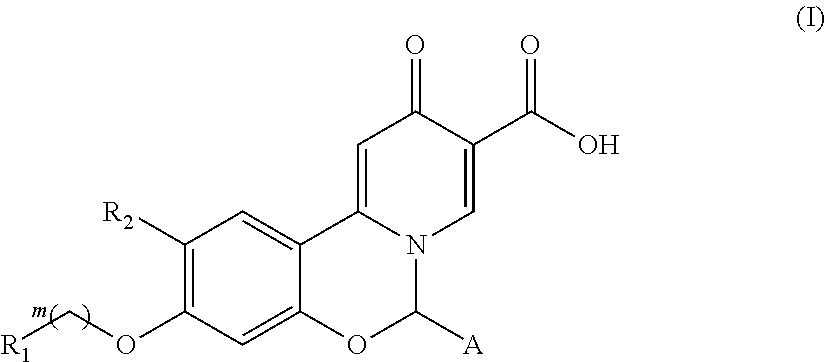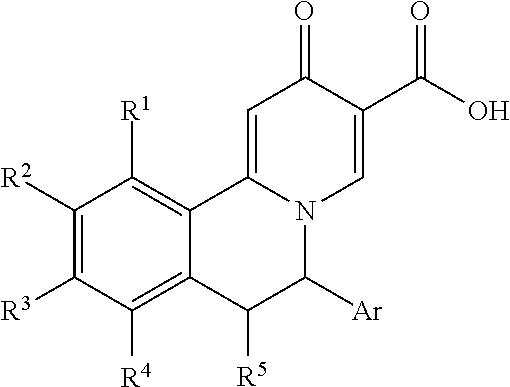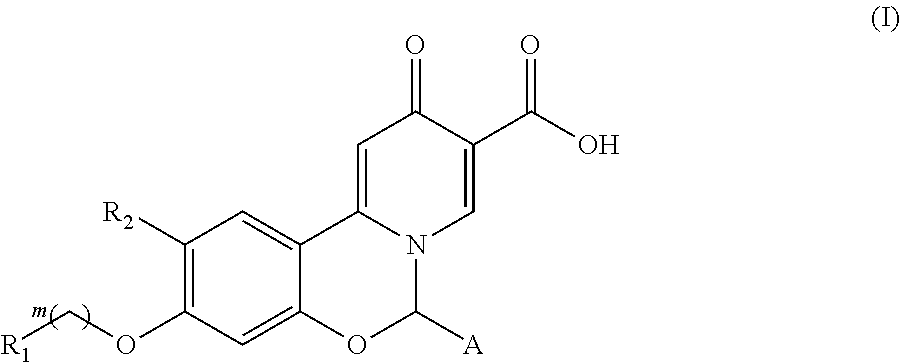Hepatitis B virus surface antigen inhibitor
a surface antigen and hepatitis b virus technology, applied in the field of hepatitis b virus surface antigen inhibitors, can solve the problems of insufficient solubility, easy aromatization, and serious hazard of series of fused ring compounds, and achieve the effects of reducing hbsag, reducing toxicity, and reducing the risk of infection
- Summary
- Abstract
- Description
- Claims
- Application Information
AI Technical Summary
Benefits of technology
Problems solved by technology
Method used
Image
Examples
embodiment 1
[0102]
[0103]Step A: 1-1 (50.00 g, 274.47 mmol) was dissolved in dichloromethane (250 mL), then sulfonyl chloride (44.45 g, 329.36 mmol) was added while stirring, the temperature was controlled between 25-30° C. The system was stirred at 25-30° C. for 48 hours. After completion of the reaction, the system was poured into 300 mL saturated sodium bicarbonate solution, then extracted by EtOAc (150 mL*3), the organic phases was combined, and washed with saturated brine (40 mL*3), dried over anhydrous sodium sulfate, then filtered and concentrated under reduced pressure. The residue was purified by a silica gel column (eluent: PE / EtOAc=10 / 1-2 / 1), giving 1-2.
[0104]Step B: 1-2 (20.00 g, 92.33 mmol) was dissolved in N,N-dimethylformamide (60 mL), then benzyl bromide (14.26 mL, 120.03 mmol) and potassium carbonate (33.18 g, 240.06 mmol) were added while stirring, the temperature was controlled between 25-30° C. The system was stirred at 25-30° C. for 48 hours. After the completion of the reac...
embodiment 2
[0114]
[0115]Step A: 1-8 (1.60 g, 3.89 mmol) was dissolved in dichloromethane (160 mL), boron tribromide (2.25 mL, 23.34 mmol) was added dropwise at 70° C., and stirred at 25° C. for 16 hours. The reaction mixture was quenched by methanol (60 mL) at 0° C., after concentration under reduced pressure and evaporation to dryness, water (50 mL) and dichloromethane (30 mL) were added, then filtered to give a solid, which was then dried under reduced pressure, giving 2-2.
[0116]1H NMR (400 MHz, DMSO-d6) δ 11.53 (br s, 1H), 8.73 (s, 1H), 8.18 (s, 1H), 7.51 (s, 1H), 7.46-7.41 (m, 5H), 7.21 (dt, J=2.4, 3.5 Hz, 2H), 6.75 (s, 1H).
[0117]Step B: 2-2 (1.20 g, 3.25 mmol) was dissolved in methanol (30 mL), thionyl chloride (2.36 mL, 32.50 mmol) was added at 0° C., the reaction mixture was stirred at 50° C. for 16 hours. The system was concentrated under reduced pressure and evaporated to dryness, the solid was washed with PE / EtOAc=3 / 1 (12 mL), and filtered to give the filter cake, which was dried unde...
embodiment 3
[0121]
[0122]1H NMR (400 MHz, CDCl3) δ 8.24 (s, 1H), 7.72 (s, 1H), 7.60-7.45 (m, 3H), 7.33 (dd, J=1.3, 7.9 Hz, 2H), 7.02 (s, 1H), 6.72 (s, 1H), 6.64 (s, 1H), 4.22 (d, J=4.6 Hz, 2H), 3.91-3.73 (m, 2H), 3.49 (s, 3H).
PUM
| Property | Measurement | Unit |
|---|---|---|
| temperature | aaaaa | aaaaa |
| Wavelength | aaaaa | aaaaa |
| Wavelength | aaaaa | aaaaa |
Abstract
Description
Claims
Application Information
 Login to View More
Login to View More - R&D
- Intellectual Property
- Life Sciences
- Materials
- Tech Scout
- Unparalleled Data Quality
- Higher Quality Content
- 60% Fewer Hallucinations
Browse by: Latest US Patents, China's latest patents, Technical Efficacy Thesaurus, Application Domain, Technology Topic, Popular Technical Reports.
© 2025 PatSnap. All rights reserved.Legal|Privacy policy|Modern Slavery Act Transparency Statement|Sitemap|About US| Contact US: help@patsnap.com



